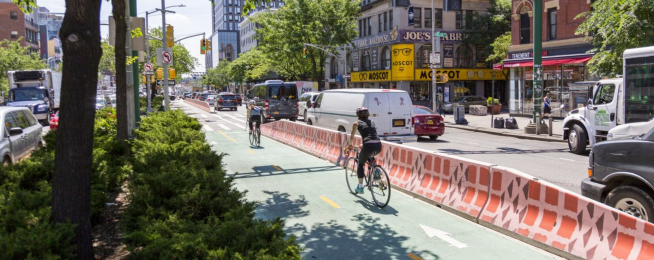The New York City Department of Transportation's Barrier Beautification Program (BBP) is commissioning artwork along separated bike lane infrastructure to improve the experience and safety of riding bikes in the city.
The DOT have been steadily transforming blank surfaces along sidewalks, underpasses and public plazas into so-called "asphalt art" for over a decade now – but the BBP also acts as an effective and inexpensive traffic-calming measure.
The artwork along barriers designed to separate bike riders from traffic aims to help immediately validate and legitimise multi-modal uses that haven’t been prioritised in the past.
As one of the only transportation departments with a dedicated arts program, New York's DOT say the idea is that artwork on the barriers is an aberration in the typically grey streetscape, which causes drivers to focus more and slow down.
“It’s not just about art — it’s about creating safe spaces for people for pennies on the dollar,” DOT commissioner Janette Sadik-Khan told Curbed when discussing the impact of asphalt art. “This is fast, easy, inexpensive, and transformative.”

This comes as New York City continues to famously transform it's streets in an attempt to "break car culture", committing to 250 new bike lanes last year as part of the Green Wave plan for cycling in the city.
Artist Ann Tarantino said "I’ve been looking at patterns in landscape and how it defines space, or power, or belonging — like [the patterns of] traffic cones, flags, and stop signs.
“Designating and carving out space for a particular type of movement validates biking as a way to get around. I do bike quite a bit; there is animosity about cyclists and that can be scary for people. I think it’s something of a political act to celebrate that space.”

Commuter (and illustrator) Gavin Snider first noticed the murals on his ride to work, before discovering they were a DOT initiative and got involved with his Shadowbox design on Delancey Street.
"It’s great that it’s a solution, but it’s a temporary solution and unfinished solution,” he says.
“In an ideal world this wouldn’t exist because there’d be lanes that are separate and protected and included in the design of the streets.… It’s an uphill battle in a city that’s car-oriented but [the DOT is] conscious and dedicated to trying to make the best of the situations. The street being for cars, bikes, and people is a never-ending challenge.”

As more bike lanes roll out across the city, the Barrier Beautification Program is set to bring in more artists and community partners — which have included middle school students, corporations, and volunteer organisations — to help paint the murals.
Become our friend
Find out more about Bicycle Network and support us in making it easier for people to ride bikes.


